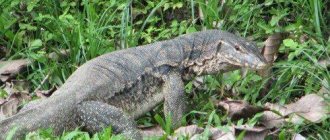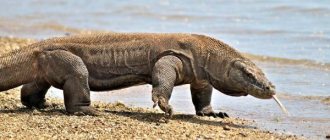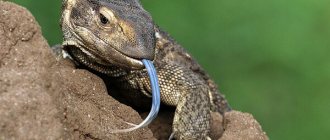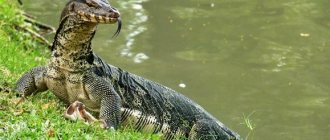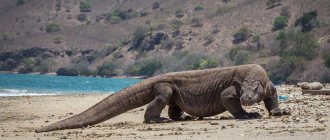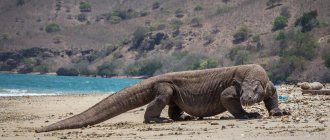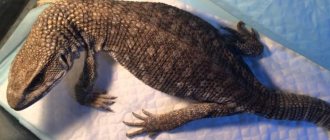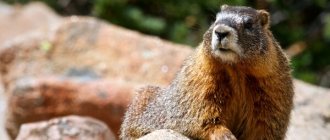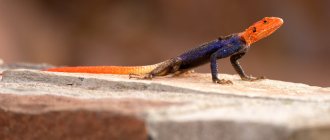| desert monitor lizard | ||
| taxonomy | ||
| Kingdom: | Animalia | |
| The wire : | Chordata | |
| Class : | Sauropsida | |
| Order : | Scaly | |
| Suborder: | Lacertilia | |
| family : | Varanids | |
| floor : | Varan | |
| Subgenre: | Psammosaurus | |
| Kinds : | B. griseus (Daudin, 1803) | |
| subspecies | ||
| Varanus griseus griseus Varanus griseus caspius Varanus griseus koniecznyi | ||
| [edit data in Wikidata] | ||
Desert monitor
(
Varanus griseus
) is a species of scaly reptile in the family Varanidae, native to North Africa and South Asia.
Varanus griseus
is a carnivorous lizard that feeds on a wide range of vertebrates and invertebrates. [ ]
Description
Gray monitor
Morphology
They usually vary in color from light brown to yellow or gray. On average they are about one meter in length, but can reach a total body length of almost two meters. These lizards may also have horizontal stripes on the back or tail, as well as yellow spots along the entire back. Their young are usually bright orange and have distinctive stripes on their backs, which may disappear as they mature. its nose is slits that are located further on its snout (closer to the eyes than to the nose), and its overall body size depends on available food, time of year, environmental climate, and reproductive status. Males tend to be larger and stockier than females, but females have a softer appearance. These differences allow males to distinguish females from afar without careful inspection. Adult desert monitors also go through periods of molting, in which they shed their outer layer of skin to increase their overall body size. This process can take several months and occurs approximately three times a year. Their fur is adapted to the desert environment in which they live, and they are excellent swimmers and divers, and are known to enter the water from time to time in search of food. [ 4 ]
subspecies
Monitor gray gray
Subspecies Varanus griseus griseus
has 5-8 narrow gray stripes on the back, as well as 19-28 on the tail. Their tail is more rounded than other subspecies, and the final size of adults depends on the habitat in which they live. Its color can vary from simple gray (in desert ecosystems) to bright (in areas with abundant vegetation). Its most common prey consists of lizards and snakes, but this can expand to include ground-nesting birds and other small mammals. [2]
Varanus griseus koniecznyi
In the subspecies Varanus griseus koniecznyi
3-5 stripes on the back, 13-19 stripes on the tail, a pointed tail, 108-139 rows of scales on the middle part and a wider and flatter head compared to other subspecies. They are found primarily in Pakistan and India and have the smallest body of the three subspecies. It has been reported that they are unable to go through the normal hibernation period during the winter but remain inactive and do not feed between December and March. Its normal diet consists primarily of invertebrates, but may also include other lizards and small mammals. [2]
Lifestyle
Varanus griseus species
They hibernate from about September to April.
There is a mass exodus in April due to their hibernation and they become more active between May and July. In the middle of the day, they mostly remain in their burrows, coming to the surface of the desert only in search of food. Monitor lizards require approximately three to four complete periods of hibernation (years) to reach full size (approximately 55-65 cm, not including the tail), and at least three periods of hibernation before they become sexually mature. The total lifespan of Varanus griseus
in the wild does not exceed approximately eight years for both males and females. [ 5]
Body temperature value
Varanus griseus
- a cold-blooded species whose behavior depends on the outside temperature.
Many monitor lizards can be lethargic in cold weather and may even become inactive if the temperature drops significantly. Its significantly slower olfactory and neural signals severely limit any lizard's ability to catch its prey or escape from a predator. The body temperature of Varanus griseus
is directly proportional to its working speed in the temperature range from 21 to 37 degrees Celsius. Between these temperatures, the desert monitor's operating speed increases from just over 1 meter per second at 21 degrees to about 3 meters per second at 37 degrees. Above 37 degrees Celsius, their running speed does not increase, and below 21 degrees they are extremely slow. If they are being chased by a predator, as long as their body temperature is below 21 degrees, they will not run away, but will instead stay in place and become extremely aggressive. The lower their body temperature, the more aggressive they are. On the contrary, it can easily escape from a threat if its body temperature is high enough to allow rapid movements. Outdoor temperature actually plays a very important role in your behavior and body functions. Okafor [6]
Body temperature of Varanus griseus
depends mainly on the ambient temperature (time of day, time of year, etc.).
It begins to heat up even before leaving the hole, receiving heat by thermal conduction; its temperature rises rapidly as soon as it begins to bask in the morning sun, culminating in the midday heat. The specific body temperature of Varanus griseus
may vary depending on the average temperatures of the country in which they live, but their maximum body temperature usually does not exceed 38.5 degrees Celsius, even while sunbathing. Male desert monitors tend to be more active and also have a higher average body temperature than their female counterparts. Lizards' body temperature during hibernation ranges from 15 to 30.5 degrees Celsius, but in many areas the average body temperature during hibernation is around 16-18 degrees Celsius [7]
Playback
Reproduction of the desert monitor usually occurs between May and July. Mating occurs in May and June, and lizards usually lay eggs in the second half of June and early July. [ 5 ] The eggs are incubated at 29 to 31 degrees Celsius and hatch in an average of 120 days. At birth, lizard babies have a total length of about 25 centimeters. [ 8 ]
Food and diet
Like almost all members of the genus Varanus
The desert monitor lizard is carnivorous. They feed primarily on rodents, fish, birds, amphibians, reptiles and their eggs, as well as insects, spiders, scorpions, centipedes and other invertebrates when given the opportunity. [ 9 ]
I
Varanus venom
is widely discussed.
Venom was once thought to be exclusive to snakes and Heloderma
(venomous lizards).
a monitor lizard
bite were thought to be due only to oral bacteria, but recent research has shown that the mouths of many, if not all species, are more likely to contain venom glands.
Although Varanus griseus
has not been specifically tested, its bites have shown side effects consistent with the venomous bites of other lizards of this type. _It may be used as a defense mechanism to ward off predators, to digest food, maintain oral hygiene, and possibly to aid in the capture and killing of prey. [ 9 ]
Gray monitor lizard: features of the lizard
The position of the monitor lizard in the evolutionary series is not entirely clear, but most zoologists believe that snakes evolved from monitor lizards. Indeed, monitor lizards living today have a lot in common with snakes: the brain of both is enclosed in a bone capsule, the neck is significantly elongated, the tongue is long and deeply forked, like that of snakes. In addition, similar signs were noted in the structure of the heart and the microstructure of the stomach. Some of the habits of monitor lizards resemble those of a snake. Thanks to the extensibility of the neck and throat, the monitor lizard can swallow large prey and eats by moving its mouth towards the victim. Particularly noteworthy is the fact that the saliva of the gray monitor lizard is poisonous, and its bite causes the same processes in the human body as snake venom.
The monitor lizard is a fast and agile lizard. It can briefly reach speeds of up to 20 km/h, makes sudden and sharp turns, and climbs trees quite well, where it usually climbs for the eggs and chicks of birds nesting there. Despite the fact that the monitor lizard is a desert animal, it swims well, in captivity willingly drinks water and loves to swim.
The monitor lizard is unusually tenacious - it is difficult to put it to sleep in ether vapor. In addition, it can remain under water for a long time. In moments of danger, it strives to hide in a hole, and if this is impossible, it presses itself to the ground and lies motionless.
The threat pose performed by the monitor lizard is very impressive - it rises on its limbs, inflates its throat, opens its mouth wide, sticks out its tongue and begins to swing its tail from side to side, while loudly hissing, periodically drawing air into its lungs and releasing it forcefully.
The gray monitor lizard is characterized by one exceptional phenomenon. Special studies have shown that it is able to tolerate huge doses of cobra and viper venom with absolutely no harm to itself. His behavior after the bite does not change and there are no signs of poisoning. There is no swelling or hemorrhage at the site of the bite, and soon its traces disappear completely. As scientists have established, the monitor lizard can tolerate up to 200 doses of viper venom that are lethal to humans and up to 4,000 doses of cobra venom. This feature gives him the ability to hunt large poisonous snakes. In Turkmenistan, for example, it eats cobras and vipers more than a meter in length.
In nature, the gray monitor lizard lives 7-8 years. The long-lived monitor lizard is also known - the gray monitor lizard was kept in the Leningrad Zoo for 17 years.
Preservation
Varanus griseus
is not threatened in most of its habitat, although much of the land formerly occupied by the subspecies
Varanus griseus caspius
has been converted to agricultural land, putting pressure on the species. About 17,000 skins of this lizard are sold annually. Although the fur trade is prohibited internationally by the Convention on International Trade in Endangered Species of Wild Fauna and Flora (CITES), in North Africa, Central Asia and parts of India the species is not protected by hunting laws and continues to be hunted. for commercial purposes. [ 10 ]
captivity
These lizards rarely outgrow it; at best, they live only a few years in captivity. In some cases, when their life needs are specifically met, they have been documented to live for over 17 years, although they never become tame and never become accustomed to being handled. [2] In captivity, their environment should reflect that of many land-dwelling animals, as well as their natural desert habitat. Hibernation requires colder temperatures in the winter and warmer temperatures in the summer months, and their diet in captivity should be similar to that in the wild. [ 8 ]
Keeping a gray monitor lizard at home
Gray monitor lizards are very rarely kept at home. It is difficult to care for them, in addition, they are considered difficult to tame lizards, and only young individuals can get used to a person over time and even let him get close.
If you decide to purchase such an exotic pet, then to keep it you will need a spacious horizontal terrarium (the minimum housing dimensions for a gray monitor lizard are 220x150x60 cm). For ventilation, both side walls of the terrarium should be made of metal mesh. During the day, the temperature in the terrarium should be maintained at 28-30°C, and at night – 22-24°C. It is necessary to equip a place in the terrarium where the lizard could warm up - at the warming up point the temperature should be 38-39°C. To maintain the required For an exotic pet, an incandescent lamp connected using a thermostat is placed in the terrarium. In addition, a fluorescent lamp with UV radiation must be installed in the monitor's home. Humidity levels should be maintained at 30-35%. Sand or a mixture of sand and pebbles is suitable as soil, the level of which should be at least 10 cm. The monitor lizard will also need shelters where he can rest, and a pond so that he can quench his thirst and swim.
Conservation status
Once upon a time, the gray monitor lizard was a common and even numerous lizard. It was mined for its beautiful and durable leather, which was used for sewing women's shoes, as well as for making wallets, bags and belts. As a result of a widespread decline in numbers, the gray monitor lizard was among the first contenders for the pages of the Red Book. Now it is listed in the IUCN Red Book and the Red Books of Kazakhstan, Uzbekistan, Turkmenistan and Kyrgyzstan, where it is classified as a species of the second category. This means that its numbers are still relatively high, but are declining catastrophically, and in the near future the animal may be on the verge of extinction.
Under natural conditions, the monitor lizard has few enemies, but it suffers greatly from humans. People do not like him and are afraid of him; unjustified cruelty is shown everywhere towards the monitor lizard. Rumors about this large lizard spread like lightning, and people cannot be convinced. There is a belief that a person who meets a monitor lizard will not have children, or some kind of misfortune will happen. Because of these prejudices, it is destroyed much more often than snakes. Many monitor lizards also die on the roads under the wheels of cars. The development of deserts and plowing of lands pushes him deeper into the desert - only here he is in relative safety. Perhaps, like no other lizard, the monitor lizard needs protection and protection.
References
- Integrated Taxonomic Information System (undefined). "Varanus griseus (TSN 202167)" (in English).
- ↑ a b c d e
Bennett, D. = com_content & task = view & id = 43 & Itemid = 76 & limit = 1 & limitstart =
0 - Mertens R., “On the races of the desert monitor lizard (Varanus griseus)”, Senkenb. biol., 1954, 35, 353-357.
- Pianka, Eric R., Dennis King, and Ruth Allen. King. Varanoid lizards of the world. Bloomington: Indiana UP, 2004. Print.
- ↑ a b
Smirina E.M., Cellarius A.Yu. Aging, lifespan and growth of the desert monitor, Russian Herpetological Journal, Vol. 3 No. 2, pp. 130-142, 1996 - , AI Effect of body temperature on running speed and defense responses of the North African desert monitor, Varanus griseus , African Journal of Biotechnology, vol. 9(5), pp. 778-781, February 1, 2010
- Ibrahim, Adel A. Radiotelemetry study of body temperature of Varanus griseus in Zaranik protected area, North Sinai, Egypt, Egyptian Journal of Biology, vol. 2, pp. 57-66, 2000.
- ^ a b c
Varanus griseus (Daudin 1803) Desert Monitor".
Archived June 10, 2010, at the Wayback Machine . - ↑ a b
Arbuckle, Kevin. The ecological role of venom in Varanus, with a compilation of dietary records from the literature, Biowak, Vol. 3(2), pp. 46-56, 2009 - Gale Group. Monitor Desert. Archived April 25, 2012, at the Wayback Machine. since 2001
external reference
- Wikimedia Commons has a media category for Varanus griseus
. - Wikispecies has an article on Varanus griseus
. - Photo of a desert monitor lizard (broken link available at the Internet Archive; see, and version).
- Photo of a desert monitor lizard (broken link available at the Internet Archive; see, and version).
| authoritative control |
|
- Data: Q838735
- Multimedia: Varanus griseus
- Species: Varanus griseus
